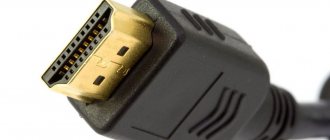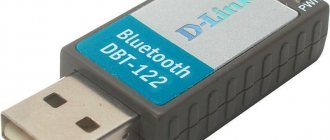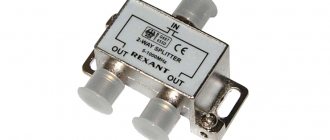Of course, it would be a lot easier if people could record and play video and audio simply wirelessly from different devices onto their TV screens. However, while some progress has been made in this area and it is a viable solution, for now we are stuck with streaming and still need wires to watch media.
In this article we will give a detailed description of one digital connector, DVI-D, which is the most common interface for connecting widescreen LCD monitors today.
What is DVI
The abbreviation DVI stands for Digital Visual Interface. Translated from English - digital video interface. Like other technologies for connecting monitors, the standard is designed to transfer information to the display for image output. A cable is made up of small wires, each of which carries a different data component. The monitor displays the received information on the screen in the form of an image.
History of the standard
The first video interfaces that appeared in computer technology were EGA, CGA and MDA. It is not worth dwelling on them in detail, but we note that they were all digital. Despite the fact that the monitors of those times were cathode ray tubes, which were more convenient for processing an analog signal, binary code was still used to transmit the video signal. The situation changed in 1987 with the advent of the VGA component interface. Unlike its predecessors, it used not zeros and ones to transmit data, but voltage fluctuations on each of the contacts. Changing the voltage on the pins responsible for colors led to a change in the brightness of the light spot on the CRT. Such a mechanism perfectly corresponded to the spirit of the times. And it made it possible to achieve the highest possible image clarity in those years.
However, technological progress did not stand still. And plasma TVs and LCD displays, used mainly in laptops, began to arrive on store shelves en masse. Unlike CRTs, they used digital data to manage information. Therefore, VGA became not the most convenient option. In addition, it was obvious that as a result of technological progress, screen resolution would only increase. And the limit for high-quality image output for analog cables at that time was 1280 x 1024 pixels. Therefore, based on the current situation, it became clear that it was necessary to develop a new, digital interface that would transmit the video signal in the form of binary code for high-resolution monitors. This interface was DVI, introduced in 1999 and soon took a strong place among data transmission technologies.
What is the difference between dvi and d-sub connectors?
First of all, it should be noted that dvi was developed somewhat later than d-sub, so it has its advantages, but the second remains a fairly universal connector, so it has a number of advantages over the one that was invented later.
If you compare these types of connectors, you can notice several significant differences between them:
- The d-sub connector is currently used for many more applications than its successor, which include such as VGA displays, as well as serial ports or, for example, parallel ports, this applies to printer or scanner ports, some gaming platforms for computer mice.
- At the same time, a dvi-type connector can receive not only analog, but also digital video signals, which makes it more adaptable to external changes, that is, more convenient for using modern technology.
- The dvi type connector is specific to video equipment, so it will be much easier to manage and there will be no need to look for any other connectors to connect everything you need.
- The dvi connector is newer than the d-sub connector and, as a result, more functional.
- At the same time, the d-sub connector is a standard connector for computers, and its successor is intended exclusively for video monitors.
- The dvi type connector is available in three versions, which do not differ much from each other, while the d-sub type connector can have a very different number of contacts and differ in different housings.
Ultimately, the modified version has a number of advantages for those users who are focused on receiving and transmitting video signals, and in fairly good quality, however, for other needs, its predecessor turned out to be more convenient and useful, since at present it does not change traditions and remains the standard computer connector. In addition, it can change its size and number of contacts if it is installed for a laptop. The variations of this connector are quite wide, which is why it is recognized as universal.
Main characteristics
The DVI cable transmits information about three colors using the RGB scheme. That is, red, green and blue. The cable itself consists of several twisted pairs. Each pair is responsible for its own component of the color system (4 in total - for each color plus synchronization). The cable throughput is quite high considering the year of manufacture of the interface and is 4.95 Gbit/s. This is enough to transmit images in Full HD resolution at 60 Hz, which modern monitors work well with. Everything would be fine, but there is a nuisance in the form of a limited cable length. When transmitting a signal over a distance of more than 3-4 meters, a loss of clarity is felt. However, this is a small problem - home and office PCs do not require a long cable. And where it is needed, the situation can be corrected by amplifying the signal.
It is worth noting that there are several subtypes of DVI connections that are found in computer technology:
- DVI-A, transmits an analog signal;
- DVI-I, capable of transmitting both analog and digital data (good because of its versatility);
- DVI-D, digital transmission only.
Interestingly, all three types have a similar connector and differ only in the placement of the contacts.
Methods for connecting equipment and components
Devices that are connected via the DVI -A port work exclusively with analog broadcasting provided by DVI-A at the other end of the cord. Connectors
DVI-D is also only compatible with each other. To achieve versatility, just choose DVI-I.
Thanks to the dual mode, the wires can double the speed of movie transfer. The frequency and quality of the picture are increasing, and the development of 3D Vision from the manufacturer NVidia certainly requires the use of Dual link.
Another option is to use adapters
, although it is fraught with deterioration in the clarity of the received content and is limited by the design of the components.
In addition to the above-mentioned DVI - VGA adapters,
special adapters are also used the DVI output to the computer
Connecting a computer to a monitor using DVI
Connecting your monitor to your computer doesn't require much effort. All you need is to find the same ports on the PC and the screen, take the appropriate cable and connect the two devices with it. The images appear on the screen without the need for further adjustment. Of course, if desired, it is possible to adjust the brightness and contrast, but this, as they say, is not for everyone.
A similar method is used to connect via DVI. The monitor and PC are connected with a cable of the appropriate type. And after that, you can customize the picture “to suit you” and feel free to use the display. The situation becomes a little more complicated if one of the devices simply does not have a suitable connector. But even in this case, it is premature to sprinkle ashes on your head. A DVI converter can save the situation.
Solution of the problem
The incompatibility problem is quite serious - but completely solvable. Due to the fact that data can not only be transmitted, but also converted, specialists have long invented another device called a DVI-D to VGA converter or converter.
In appearance, it may indeed resemble a regular adapter, but it is equipped with an additional module that increases the size of the device.
Rice. 6. DVI-D VGA converter.
The task of the device is to convert a digital signal to analog. And, due to its more complex design, such a converter costs several times more. on the other hand, the question arises: why are DVI-D VGA adapters sold in online stores?
It is not difficult to answer - the reason lies in the incompetence of some sellers. Or, perhaps, in the desire to sell more of a product that does not have the functions for which it is bought. In fact, on sites where reliable information about adapters and cables is provided, you can see other parameters in the description - the transition is carried out not from DVI-D, but from DVI - I to VGA.
Rice. 7. Correct indication of adapter parameters in the online store.
DVI converter
As a rule, if there is no DVI connector, there are two others to choose from – HDMI and VGA. Of course, if possible, it is advisable to use a digital connector. Firstly, a simple inexpensive adapter will be enough to connect, since the data transfer method is the same. Secondly, it will be possible to avoid data loss, which inevitably occurs when converting a signal from digital to analog. However, it often happens that the HDMI connector is already occupied by a TV or other device. In this case, there is no other option but to try to connect via the analog output of the PC.
To connect DVI monitors to the VGA output, you will need an adapter. Although such “toys” are found on sale, they are obviously useless and are not worth even a minute of attention. The fact is that these two interfaces transmit information in two different ways. While in digital DVI-D transmission occurs through binary code, in VGA this role is performed by changing the voltage. Therefore, a simple DVI to VGA cable will not work. Only a full-fledged converter can cope with the signal conversion process. It costs a lot, but you can’t do without it. A working DVI to VGA adapter must include a converter board. In this case, by connecting a monitor through it, the user will receive a working circuit that will allow him to safely use the monitor even in the event of a mismatch of interfaces.
Another type of adapter is a splitter. Why is it needed? For example, if there are two DVI monitors that it is desirable to connect to one port. A DVI splitter for 2 monitors can be easily found on sale. It allows you to free up other ports on the video card by connecting monitors to one connector. It is worth noting that if both displays are high resolution, then one of them will experience image clarity problems. It's all about maximum interface throughput. However, for ordinary monitors the decision to use a splitter is justified.
Compatibility issues
If you compare the signals that go from the DVI-D port to the VGA connector, you can conclude that they are different. And in order to correctly transfer information in digital form to an analog monitor, you can use adapters from one interface to another - or signal converters with the same ports. When considering purchasing a regular DVI-D/VGA adapter, you should be aware of the compatibility issues that most users will have to face.
Which is better: DVI or VGA?
When we talk about two different technologies that were popular around the same time, the question arises: which one should be preferred?
First, let's pay attention to the type of signal transmission. As mentioned above, VGA is designed for CRTs. Therefore, an analog signal was the best choice at that time. With the start of production of LCD displays, their manufacturers worked hard to adapt the interface to digital devices, but there were problems. When converting information, losses are inevitable, which leads to image deterioration. And, in general, the “reserve” of analog interface bandwidth turned out to be insufficient for modern models. And even Full HD monitors are beginning to experience a deterioration in picture quality.
Unlike VGA, DVI-D is a digital interface. The resulting signal can be immediately displayed on the display, without the need for additional processing. This avoids unnecessary quality losses. In addition, the bandwidth allows you to easily output resolutions of 1920x1080 and even more. Therefore, DVI can be considered the best option for most modern monitors.
Of course, both interfaces are inferior to the current technology leader, HDMI. However, if you choose exclusively between VGA and DVI, then preference should undoubtedly be given to the latter.
S-video - analog data for TV.
S-Video (English: Separate Video, separate video signal) is a component analog video interface that provides for separate transmission of video signal components: brightness Y together with the synchronization signal, and chrominance C (together with color synchronization), which are transmitted over two separate communication lines, with characteristic impedance 75 Ohm. Separate transmission of luminance and color provides higher image quality than composite standards, since crosstalk is eliminated when the signals are separated.
The S-Video interface is used only for transmitting standard definition television signals and is not suitable for HDTV. A separate cable is required for audio transmission.
Standard four-pin S-Video connector, female type: 1. GND - ground (Y), 2. GND - ground (C), 3. Y - Brightness, 4. C - Chroma.











